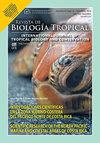The role of the length spines of echinoids in their association with crustacean and fish in Los Cabos, Baja California Sur, Mexico
IF 0.6
4区 生物学
Q4 BIOLOGY
引用次数: 0
Abstract
Introduction: Echinoids (sea urchins) provide shelter for a variety of facultative or obligatory ectosymbionts. Objective: To evaluate the hypothesis that decapods and fishes prefer to associate with echinoid individuals and species that have longer spines. Methods: We visually studied the frequency of decapod crustaceans and fishes associated with echinoids in shallow water (< 4 m) and deeper water (5-20 m) at Los Cabos, Baja California Sur, Mexico, during 1-6 January 2019. Results: We inspected 1 058 echinoids of six species. Five decapod species associated with three species of echinoids. When compared with other echinoid species, in shallow water, decapods associated 5.1 times more often with the longest-spined echinoid Diadema mexicanum (7.0 times more decapods per individual D. mexicanum); in deeper water, association frequency was similar for all echinoid species. Fourteen fish species associated with four echinoid species. In shallow water, fishes associated 2.6 times more with D. mexicanum (4.5 times more fishes per individual). There was no preferred echinoid species in deeper water. Longer-spined D. mexicanum had more decapods and fishes. Associations were more frequent in shallow water. Multiple individuals and species of decapods and fish often associated together with a single D. mexicanum. The decapod that presumably is Tuleariocaris holthuisi showed a possible obligatory association with one of the equinoids (D. mexicanum); the other decapods and all fish species are facultative associates. Conclusion: Our results support the hypothesis that decapods and fishes associate most frequently with echinoid with the longest spines, presumably to reduce the risk of predation.在墨西哥下加利福尼亚南部洛斯卡沃斯,刺类动物与甲壳类动物和鱼类的联系中,刺类动物的长刺的作用
简介:棘皮动物(海胆)为各种兼性或强制性的外共生体提供庇护。目的:评价十足目和鱼类更喜欢与棘皮动物个体和棘较长的物种联系在一起的假说。方法:2019年1月1日至6日,我们在墨西哥南下加利福尼亚州洛斯卡沃斯的浅水(<4米)和深水(5-20米)中,对与棘皮动物相关的十足目甲壳类动物和鱼类的频率进行了视觉研究。结果:共检出6种1058个棘皮动物。与三种棘皮动物有亲缘关系的五种十足目动物。与其他棘皮动物物种相比,在浅水中,十足类动物与刺最长的墨西哥棘皮动物Diadema mexicanum的联系频率是前者的5.1倍(每个墨西哥棘皮生物的十足类动物是前者的7.0倍);在较深的水域,所有棘皮动物的关联频率相似。14种鱼类与4种棘皮动物有亲缘关系。在浅水区,鱼类与墨西哥D.mexicanum的亲缘关系是前者的2.6倍(每个个体的鱼类数量是后者的4.5倍)。在较深的水中没有首选的棘皮动物。长刺的D.mexicanum有更多的十足目动物和鱼类。浅水区的关联更为频繁。多个个体和种类的十足目动物和鱼类通常与一个墨西哥D。推测为Tuleariocaris holthuisi的十足目显示出可能与其中一个春分目(D.mexicanum)有必然联系;其他十足目动物和所有鱼类都是兼性伙伴。结论:我们的研究结果支持了这样一种假设,即十足目动物和鱼类最常与棘最长的棘皮动物联系在一起,可能是为了降低被捕食的风险。
本文章由计算机程序翻译,如有差异,请以英文原文为准。
求助全文
约1分钟内获得全文
求助全文
来源期刊

Revista De Biologia Tropical
生物-生物学
CiteScore
1.80
自引率
0.00%
发文量
23
审稿时长
4-8 weeks
期刊介绍:
The Revista de Biología Tropical / International Journal of Tropical Biology and Conservation is a mainstream scientific journal published since 1953 and covered by Web of Science; Science Citation Index; Current Contents; Google Scholar; Scopus, SciELO and nearly 50 additional indices.
A double blind system guarantees you a fair evaluation, and our world class editorial and scientific boards provides a first decision in three working days. The journal is Full Open Access and is widely read where your article can have the highest real impact.
Since its beginning in 1953, the Revista follows these principles: objective and independent evaluation of all manuscripts; transparency in all processes; ethical use of procedures, data, specimens and subjects; fair treatment of all parties; and absolute predominance of scientific rigor over any other aspect.
 求助内容:
求助内容: 应助结果提醒方式:
应助结果提醒方式:


